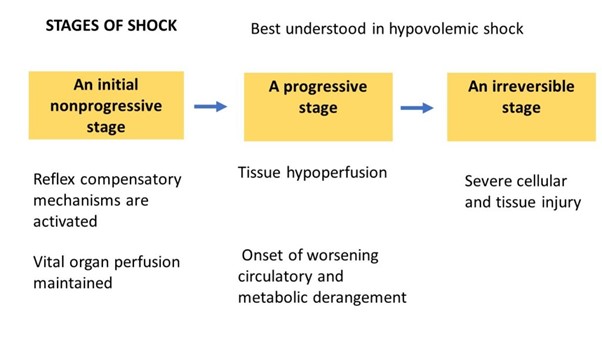What typical sign/symptom indicates the early stage of septic shock?
Tachypnoea and tachycardia
Pallor and cool skin
Blood pressure 84/50 mm Hg
Respiratory acidosis
The Correct Answer is A
In the early stage of septic shock, the body initiates compensatory mechanisms to combat the infection and restore adequate tissue perfusion. Tachypnoea (rapid breathing) and tachycardia (elevated heart rate) are common early signs of septic shock.
Tachypnoea occurs as a response to increased metabolic demand and to compensate for impaired oxygenation and tissue perfusion. Tachycardia is the body's attempt to maintain cardiac output and compensate for decreased blood pressure.
B. Pallor and cool skin in (option B) is incorrect because Pallor and cool skin can occur in later stages of septic shock when perfusion to the peripheral tissues is compromised. However, they are not specific to the early stage.
C. Blood pressure 84/50 mm Hg in (option C) is incorrect because A blood pressure reading of 84/50 mm Hg indicates hypotension, which is typically seen in later stages of septic shock. In the early stage, blood pressure may still be within normal or slightly decreased range.
D. Respiratory acidosis in (optionD) is incorrect because: Respiratory acidosis refers to an imbalance in acid-base status and is not specific to the early stage of septic shock. Acid-base disturbances may occur at any stage of shock but are not indicative of the early stage.

Nursing Test Bank
Naxlex Comprehensive Predictor Exams
Related Questions
Correct Answer is B
Explanation
Shock is a state of inadequate tissue perfusion, resulting in compromised oxygen and nutrient delivery to cells and impaired cellular metabolism. Regardless of the specific cause or type of shock (e.g., hypovolemic, cardiogenic, distributive), the underlying problem is the failure to supply sufficient oxygen and nutrients to the body's tissues. This inadequate tissue perfusion can lead to cellular dysfunction, organ failure, and ultimately, life-threatening consequences.
A. Inefficient metabolism resulting from inadequate nutrition in (option A) is incorrect because While inadequate nutrition can contribute to the overall health status and resilience of an individual, it is not the central mechanism underlying all shock states.
C. Vasoconstriction and reflexive vasodilation due to circulating mediators in (option C) is incorrect because Vasoconstriction and vasodilation are physiological responses that can occur in various types of shock, but they are not the fundamental common denominator. Inadequate tissue perfusion remains the core issue.
D. Hypovolemia resulting from blood loss in (option D) is incorrect because Hypovolemia, which refers to decreased blood volume, is one potential cause of shock, specifically hypovolemic shock. However, other types of shock, such as cardiogenic or distributive shock, may not be primarily characterized by hypovolemia.
Therefore, the common denominator of all shock states is inadequate tissue perfusion, resulting in impaired cellular metabolism.
Correct Answer is D
Explanation
The absence of palpable pulses suggests a lack of effective cardiac output, and the patient is in cardiac arrest. In this situation, immediate initiation of cardiopulmonary resuscitation (CPR) is crucial to maintain circulation and provide oxygenation to vital organs.
CPR consists of chest compressions and rescue breaths to circulate oxygenated blood to the brain and other vital organs. It is the primary intervention in cardiac arrest to provide temporary life support until advanced cardiac life support (ACLS) measures, such as defibrillation or medication administration, can be initiated.
A. Administering the prescribed Beta-Blocker in (option A) is incorrect because Administering a beta-blocker is not the initial action in a patient who is in cardiac arrest and requires immediate resuscitation.
B. Prepare for Cardioversion per hospital protocol (option B) is incorrect because Cardioversion, which is the delivery of an electric shock to the heart, may be considered in certain situations like unstable ventricular tachycardia or certain supraventricular tachycardias. However, in the given scenario, the patient is unresponsive and has no pulses, indicating cardiac arrest where CPR takes precedence over cardioversion.
C. Give 100% oxygen per non-rebreather mask in (option C) is incorrect because: While oxygenation is important, it should not delay or replace the initiation of CPR, which is the immediate priority in a patient without palpable pulses.
Therefore, the first action that the nurse should take in this scenario is to start CPR.
Whether you are a student looking to ace your exams or a practicing nurse seeking to enhance your expertise , our nursing education contents will empower you with the confidence and competence to make a difference in the lives of patients and become a respected leader in the healthcare field.
Visit Naxlex, invest in your future and unlock endless possibilities with our unparalleled nursing education contents today
Report Wrong Answer on the Current Question
Do you disagree with the answer? If yes, what is your expected answer? Explain.
Kindly be descriptive with the issue you are facing.
